I went and saw Dungeons & Dragons: Honor Among Thieves in a theater, and I’m going to talk about it!
Continue readingTag Archives: Dungeons & Dragons
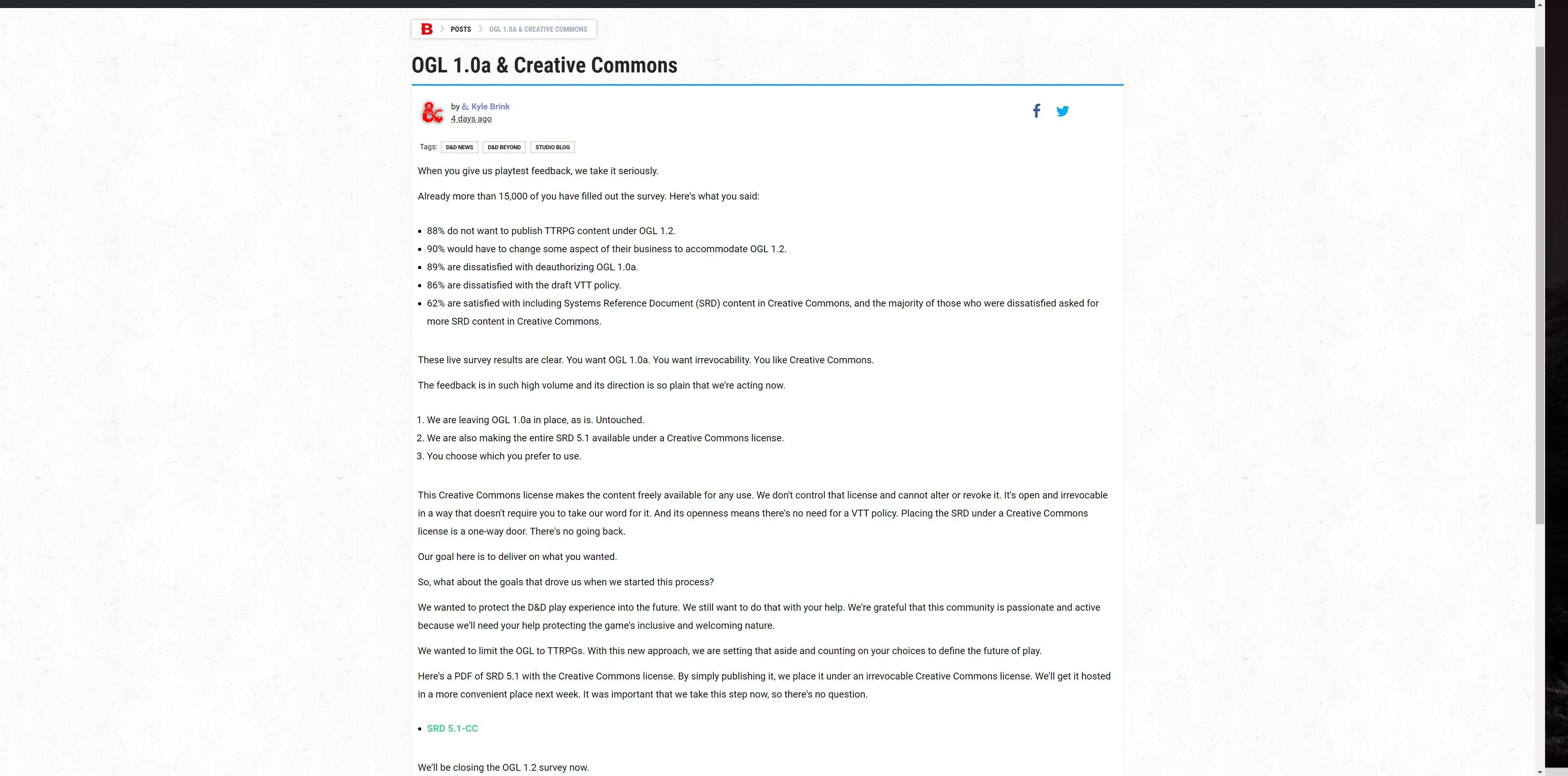
Vlog: Getting Up To Date On the OGL
Things changed a lot since I put my editorial on why the OGL matters – just two days after that video went live in fact. It’s time to go over what had changed, and what my thoughts on the changes are.
Continue reading
Editorial: Why the OGL Matters
In the wake of Wizards of the Coast announcing that they are revoking OGL V1.0a, there have been a bunch of hot takes that the OGL does not matter and it and other licenses never mattered – so I get into a few of the legal cases that made the OGL important, and which makes current open gaming licenses important.
Continue reading
The Elusive Shift: Book Review
In writing my review of The Game Wizards, I came to a horrifying realization – I hadn’t given my thoughts on the other previous sequel by Jon Peterson to Playing at the World that I’d read – The Elusive Shift. Considering that all three of these books kind of form a full narrative, I realized I really needed to rectify that situation. So I’m rectifying that situation.
Continue reading
Dragons of Winter Night: Book Review
Dragons of Winter Night, as a novel, runs into the problem of adapting what was we think of it into just a trilogy of books – a bunch of material has to be skipped over. We start off after the retrieval of the Hammer of Karass and the re-unification of Dwarven society (which would later be covered in Dragons of the Dwarven Depths), with that kind of setting the tone somewhat for how the show comes out.
Continue reading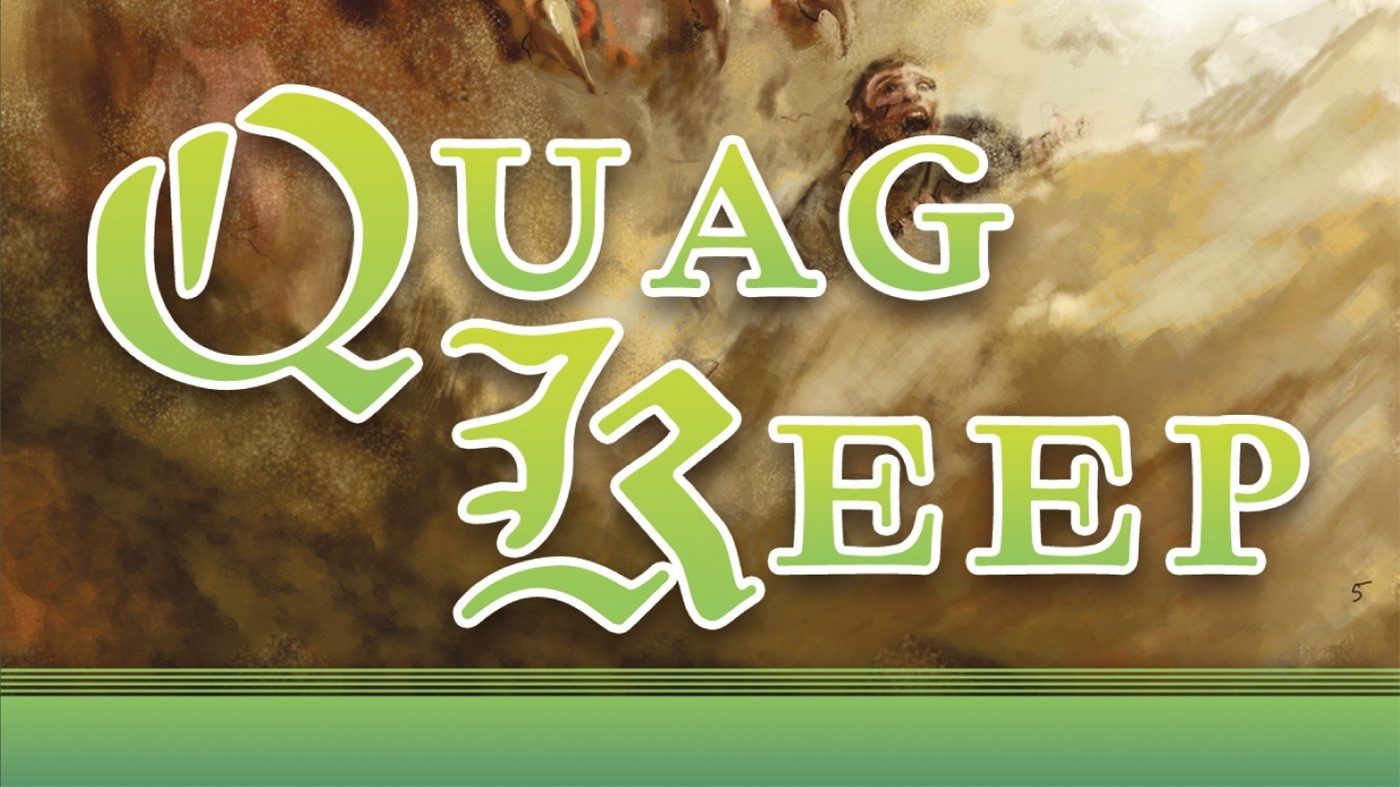
Quag Keep: Book (Video) Review
This week I’m rounding out my book reviews with what might be the proto-Game-Isekai novel, written in the ’70s by Andre Norton.
Continue reading
Quag Keep: Book Review
If I was going to describe the modern “Isekai” genre in brief, I’d describe it as “Game-based another world fantasy.” It’s not just fantasy where a protagonist is whisked to another fantastic world from ours like with the John Carter of Mars novels, or on the anime front with El-Hazard and Magic Knight Rayearth. This is fantasy where the characters are explicitly in a world that draws inspiration to games from gaming – sometimes by drawing the characters or their psyches into an actual game (ala Sword Art Online or Log Horizon), or a world which uses the language of RPGs like with Konosuba or Grimgar: Ash and Illusions. I would argue that if not the first of these, then one of the first of this particular genre – and was done in the ’70s by a woman.
Continue reading
Book Review: Dungeons & Dragons – Art & Arcana
This week I have a review of an art book covering the history of Dungeons & Dragons from the start of the game to now.
Watch the video…
GBP: Pool of Radiance – Part 3 (Kuto’s Well)
Once Sokal Keep has been cleared, now you’ve gotten the attention of the government of New Phlan – as the room behind the counselor opens up, and Junior Counselor Cadorna asks to meet with you. Cadorna is one of the few NPCs in the game with a truly unique character portrait – one that wasn’t created with the portrait system that you would have used to create your party when you started the game.

Cadorna’s family has roots to Phlan long before it fell – and he’s got a job for the PCs – retrieve some treasure the family stashed before they had to flee. However, the Textile House – where the goods were stashed – is in the corner of town between Podol Plaza and Mendor’s Library, so that quest will have to wait until after either of those two quests.
However, in order to get to either of those quest locations, you’ll have to go through the city hex of Kuto’s Well.

This is the first hex we’ve entered thus far that doesn’t actually have a story hex attached to it – but in order to clear the town, we have to clear this area, though the party only gets the normal “Hex Clear” reward for doing that. Still, that’s generally enough motivation for the player to clear this hex.
By taking on this hex, the player is introduced to a few new concepts. For starters, this is the first multi-layer dungeon the player has faced in the game thus far. Every other hex has been a single part of town – so there’s that.

Second is traps. Several squares in the catacombs (until you take out the bandit leader – Norris the Grey) will result on you getting shot at if you pass through them – and you’ll have to pass through at least one of them to reach Norris – who can show up at multiple places (and will appear t whichever of those places you get to first.
I have mixed thoughts on this. On the one hand, I wish that if you were actively searching and had a thief in your party, you could have a chance to completely evade the ambush. Alternatively, if you weren’t evading the ambush by random chance, I would like the idea of placing the ambushes in locations where the party could maneuver around them, with the thief having a chance to spot what squares contained the ambushes. That would provide a way, in the context of this video game, to emulate how in a tabletop session the Thief’s powers of observation can permit them to get the drop on an enemy or to evade an ambush or patrol.

That said, the fight with Norris himself and his men isn’t too hard of an encounter – provided you’ve kitted your spellcasters out with area of effect spells that can take groups of people out of the fight. I took Norris’ minions out with sleep spells and took Norris himself out of the fight by catching him in a Stinking Cloud, at which point we were easily able to dispatch him.
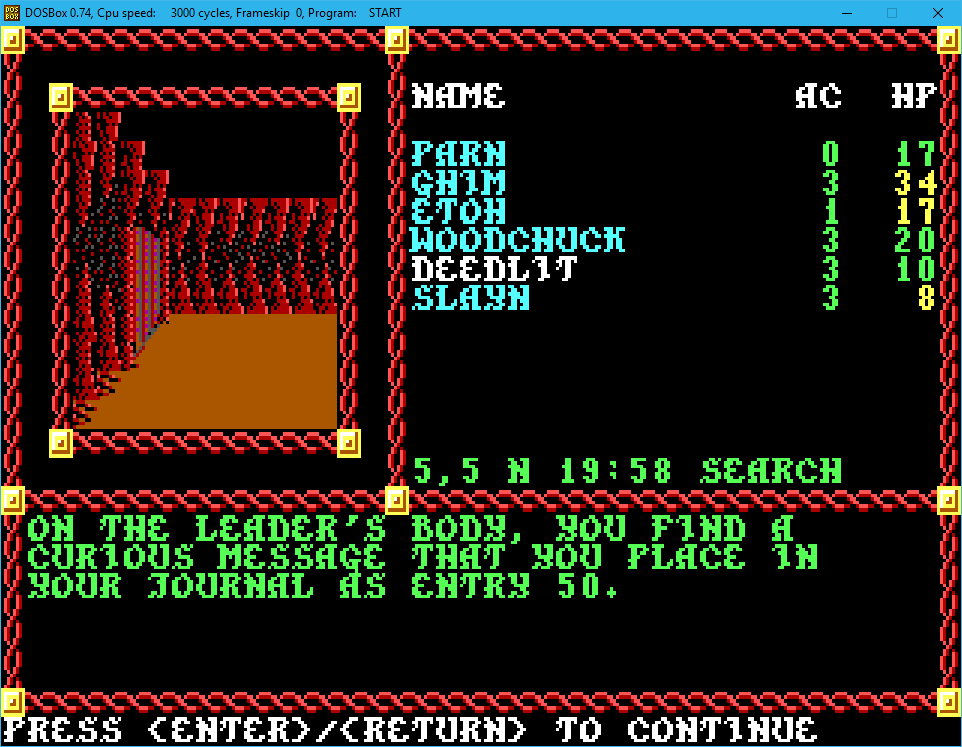
Beating Norris also gets another journal entry – which in turn provides some story content. Specifically, that the forces holding Old Phlan are not a unified front. There is a note from “The Boss” calling for Norris and his troops to assist in holding Sokal Keep, and Norris basically telling “The Boss” to shove it up his ass. Now, he didn’t actually send the message – but the reasoning for his not sending it isn’t clear.
However, clearing out Norris basically clears out this city hex, and allows you to return to town and collect your reward for pacifying it.
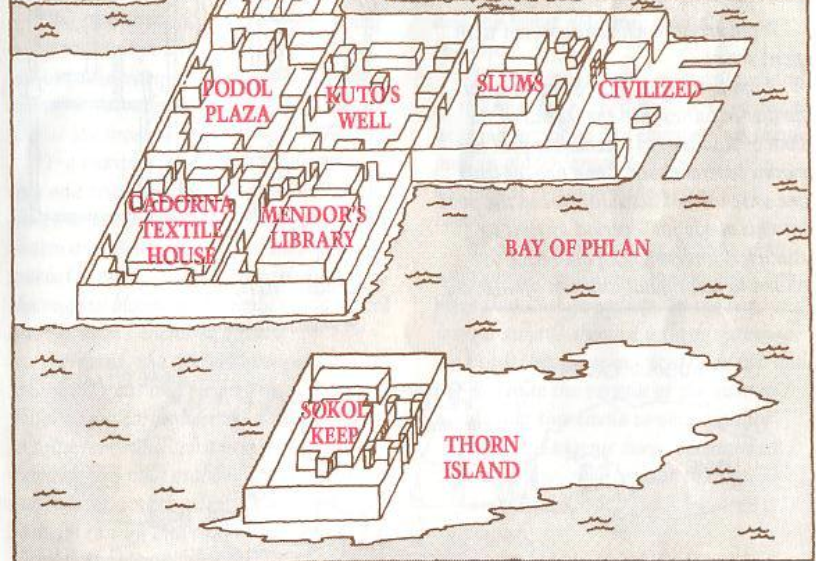
GBP: Pool of Radiance – Part 2 (Sokol Keep)
After you’ve cleared the Slums – in terms of quest goals, you have a few new options. On the one hand, you can continue inland to Kuto’s Well. On the other, you can now travel out to Sokol Keep out in the bay around the city. With this comes a bunch of new quest goals as well. One quest goal tasks the party with spying on the auction for a weapon in Podol Plaza, several city hexes inland. The other explicitly tasks the party with going out to Sokol Keep and clearing that – steering the player in that direction for their next quest, so I’ll be covering that hex next.

Sokal Keep is significantly different from the Slums – random encounters are with the spirits of the undead defenders of the keep, and not only do they only appear in a limited area of the map, but they also are completely avoidable with the use of the right password. That password is one of the three found on a piece of paper in the very first room of the keep. That piece of paper also leads to the first things that this portion of the game is teaching you to use as well, and that is the code wheel.
By way of explanation, Pool of Radiance shipped with a rotating code wheel. When playing the game, the majority of your interactions with this would be with the copy protection when you first opened the game to play. However, occasionally, the game would pose situations where you would need to translate certain words in either Elven or Dwarven text in the game’s environment as part of various puzzles. The document here introduces the code wheel in a relatively low-pressure environment. If you decode the text with it, you have a way to avoid random encounters and save your resources. If you don’t, then you’ll have to fight some random encounters that will drain your resources – but won’t outright stop you from progressing in the game.
The next thing this area introduces is poison. By this point in a Wizardry or Might & Magic game, you probably would have been poisoned at least once by a drop from a random encounter whose trap the thief hadn’t successfully disarmed. However, after combat loot doesn’t work that way in Pool of Radiance so any treasure you would have picked up in the Slums would not have been trapped so you wouldn’t have had to contend with poison.
Here, on the other hand, the encounters around the perimeter of the keep all, in some manner or another, have poison (with the exception of the Boss encounter). Consequently, in order to succeed in this area of the dungeon, you’ll need to have a divine spellcaster (whether a cleric or a druid) in the party to cast Slow Poison while you withdraw to town to pay for a healer – this leads me, briefly, to money.
In most modern RPGs, even dungeon crawlers, what you use the money for are expendables (healing and escape items, some offensive items) or upgrades. In Wizardry, money is used for healing and identification. Pool of Radiance, like Might & Magic, uses money the way AD&D 1st edition uses it – to cover expenses for healing and for training. However, unlike Might and Magic, here money has weight. Like, actual, physical weight. This means that when you travel around and find jewelry and gemstones, you don’t actually want to convert those to cash money. Appraise them, absolutely, but they’re more useful to you in their original forms instead of as cash because they weigh less that way. You convert them to cash when the time comes to level up or when you need to have some expensive healing done. So, while The Slums would have taught you the value of money when the time came to level up, Sokal Keep teaches you the value of money when it comes to healing (though, if you were coming to this game from Wizardry and Might & Magic, you’d know this already).
The next lessons the game teaches you come through the boss battle in area 6. This battle puts you against the largest group of enemies you’ve faced thus far in the game, and serves as something of a test of your understanding of the combat system, and some of the spells in the magic system – in particular area of effect spells like Sleep and, since you’ve leveled up a few times at this point, Stinking Cloud and Hold Person.
This fight puts you up against a boatload of goblins, hobgoblins, and a small handful of goblin leaders – no trolls, ogres or anything similar. You’ve handled loads of these in smaller numbers in the Slums, but here they’re coming with enough numbers to overwhelm you if you’re not capable. Consequently, the spell loadout you use coming into this battle is incredibly important.
Similarly – you have three different entrances you can use going into the battle, and which entrances you use are also very important. The two at the bottom, which you can access without having to clear the side rooms, puts you at a position where the gobbos have to go through a bottleneck, making it harder for them to flank you, and putting them in a position where they’re in range of your AOE spells, instead of the northern entrance, where you (and they) have to close, and they’re in a better position to flank you.
After the fight – we get our first Journal Entries of the game – longer areas of text that are kept in the Adventurer’s Journal to save space on the original floppy disks. Here we get our first mention of “The Boss” the leader of the forces in the Old City who is planning to crush New Phlan.
This is expanded on in a dialog with the ghost of the fortress’s last commander – Ferran Martinez. If you talk with him instead of fighting him, he provides a list of names of the three powerful beings behind the fall of the city – setting up the possibility that one of these three is “The Boss”.
If you enjoyed this article and would like to read future articles up to a week early, please consider backing my Patreon. Backers get reviews up to a week early.
Or you can just toss a few bucks in my Ko-Fi Jar if you want to help out but the Patreon isn’t a viable option.

GBP: Pool of Radiance – Part 1 (Arrival and The Slums)
Recently, in addition to the games that I’ve been playing for my usual Let’s Plays, I’ve also been playing the original Pool of Radiance as part of a planned playthrough of the Forgotten Realms Gold Box games. Since I can’t really engage with something without getting analytical, I figured I might as well give my thoughts on it as I go through the games. Further, since the way the games work isn’t entirely conducive for entertaining streaming, I thought I would give my thoughts in blog form. These blog posts will be going based on each section of the game, instead of going by session, as I feel the breakdown will work much better that way.
The game begins in the “Civilized Quarter” of the city – the chunk of the city that has been reclaimed from monsters and which will serve of your base of operations throughout the game.

It also literally opens with a tour. As in your party of adventurers gets a guided tour through the city telling you where everywhere you need to go is – the temples, training halls, shops, and city hall, ending right at the entrance to the Slums. And here’s where some of the really good map design pays off because unless you are acting with a surplus of braggadocio, the very next thing you are going to do is immediately turn around so you can go buy some gear before you go wandering into the city. At which point you will walk into the grid square next to the city hall, and the game will give an automated list of posted proclamations – which in turn will let you know some (though not all) of the quests that you can take on to start the game.
In particular, the posted quests have two main thrusts. The first is a bunch of quests related to the Valhigen Graveyard. These are an array of quests related to investigating the Graveyard… and a couple quests related to finding out the fates of a couple previous groups of adventurers who were sent to the Graveyard. This sends the message to the player that the Valhigen Graveyard is not an area of the game that low-level characters stand a chance of surviving in.
The second is a quest stating that the Council is offering a reward for the clearing of areas of the city. Now, at this point in the game, you don’t have any way to get to the Graveyard – but you do have access to the Slums. This sets a goal for the player and a way to get there that will, in theory, result in them being sufficiently equipped to take on the foes they face in the graveyard.

This leads to the Slums. This is the first area of the city you have access to – you’ll get a couple more options after you clear this area, but for now, you’ve just got the Slums. This area of the game is designed to train the player in a few concepts – combat, exploration, negotiation.
Exploration is pretty self explanatory. In order to clear this area, you have to complete every set encounter, plus a bunch of random encounters, which means you need to wander around and check every room. If you don’t explore, you can’t proceed in the game.
Combat is related to the combat system in the game itself. A lot of RPGs prior to this point had abstracted combat like in Wizardry and the Might & Magic games – the closest combat got to being “tactical” was related to front and back ranks of combat. Ultima 3, which pre-dated this, had more tactical combat, but the actual map of the dungeon was not reflected in the combat areas, and Ultima 4 and 5 generally handled combat the same way.
However, Pool of Radiance has the dungeon map reflected in your combat area, and the Slums introduces that. You are not in a position yet where you have to take advantage of this to succeed in combat. Instead, this area of the game introduces you to this in a low-pressure manner – both in terms of the difficulty of the encounters, and in terms of how far you have to travel in order to get back to town. This gets the player thinking tactically, both in terms of combat and in terms of equipment – in Pool of Radiance, any character who can use a ranged weapon should have a ranged weapon – because having ranged weapons means that you can engage with enemies before they close to melee.
Additionally, the effective “boss” encounter for the Slums involve Trolls, which regenerate, which means you have to change your tactics against them, because they can’t regenerate if there is a player standing on one of the hexes the trolls were on when they died. So, that introduces this concept for future fights.
Finally, there is negotiation. Several rooms in this are of the dungeon have people who you not only can talk to, but preferably should talk to – specifically Ohlo and the Fortune-Teller. Both of these people can be killed by the party, but there are repercussions for doing so. Ohlo will bust out a bunch of monsters if you fight him directly, making for a very difficult fight that can potentially wipe the party. Meanwhile, the Fortune Teller is explicitly a non-combatant, and killing her causes all subsequent encounters, random or otherwise, to become much more difficult. It sets the idea that not everything you meet is a combatant, and that negotiation and discussion can work better than fighting. This will play out in the next area of the game – Sokal Keep.
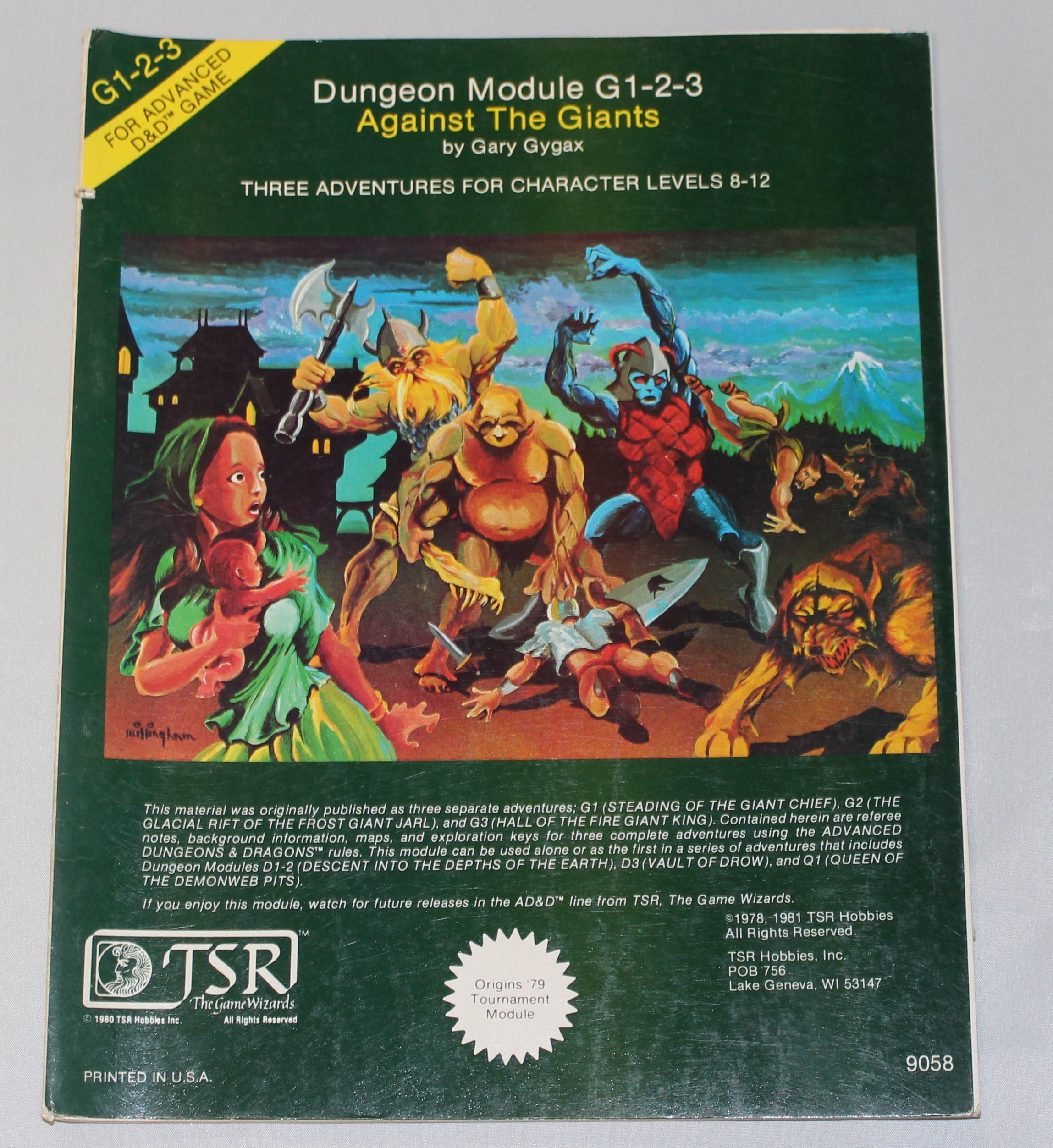
Adventure Review: G2 & G3 – The Glacial Rift of the Frost Giant Jarl & The Hall of the Fire Giant King
A while back, I reviewed G1: The Steading of the Hill Giant Chief, an adventure that launched AD&D’s first real adventure path, and had some really interesting adventure design concepts. The other two adventures in the series – G2: The Glacial Rift of the Frost Giant Jarl and G3: The Hall of the Fire Giant King, are much more conventional dungeon crawls, so they’re worth discussing together. Continue reading

Book Review: Dragons of Autumn Twilight
When I first read Dragons of Autumn Twilight, back in Middle School, I hadn’t read much fantasy fiction, and I definitely hadn’t watched much anime. This year, I decided to revisit the Dragonlance trilogy, with what I know now about Fantasy fiction, with a more mature perspective as a reader, and having watched (according to MyAnimeList) 66.5 days worth of anime between when I discovered Anime in Middle School and now.
The first book, in a way, starts of in a cliched fashion, but in a very self-aware cliched fashion – Group of adventurers meet in a bar and are kicked out the door on the road to adventure. In this case, the adventurers are a band of heroes who have mostly known each other for years who left to travel the world because they suspected that there was some Weird Shit going on, and returned with the answer “I dunno, but there’s some Weird Shit going on.”
The heroes are Flint Fireforge (Dwarfy Dwarf), Tanis Half-Elven (Ranger With Dice Lice), Sturm Brightblade (Kinda Lawful Stupid Cavalier/Paladin), Tasslehoff Burrfoot (Kender Thief whose player wants to play the comic relief), Caramon Majere (Fighter with good Con, Str, and Cha but not great Int and Wis), and his brother Raistlin (Mage who rolled 18s for Int and Wis, and 8s for everything else).
They are kicked out the door with the arrival of two barbarians – Riverwind and Goldmoon. The two have obtained evidence that after the Gods had left the word of Krynn centuries before in a great Cataclysm, they are returning to the world. The existing theocratic governments consider this a threat to their power, and the forces of the Goddess of Evil want to cover this up because they don’t want people to know that the Goddess of Evil is quite back yet (or at least that there’s an alternative).
Re-reading the book, I found in my mental pictures of the characters that they easily fit into more anime-inspired portrayals. Much of the humor in the book comes from either characters doing something dumb and being “corrected” for doing it, or through characters getting into silly situations and reacting to them in a comedic manner. At several points through the book I found myself coming up with “omake” strips for the story, or thinking about how it would work as a sort of “Dragonlance Abridged” webcomic.
As an aside, if that doesn’t exist, then it totally should.
The writing is generally okay. It gets a little male-gazey at parts. Admittedly, this happens when the POV character is male, but on the other hand, you can have a male character describe a female character who they’re attracted to without getting into describing their boobs and thighs. On the other hand, Weis and Hickman have the best Dragon descriptions and internal narratives in the business. Each of the dragons we encounter in this story are absolutely terrifying, killing their victims that, to continue the anime comparison, would fit in nicely with a late 80s, early 90s OVA or film.
The characters are two dimensional, but not in a bad way. These don’t have the character depth as the characters from Game of Thrones, but they fit well into archetypes, and archetypes can sometimes work to help the reader know their way around a work. That said, it’s where the writers go with those archetypes in the second installment that really decides how the series goes. To use the Star Wars comparison, by the end of A New Hope, everyone is still fairly stock archetypes. It’s Empire Strikes Back where they go into new and interesting directions.
I definitely enjoyed reading the book – though I recognize that this is the literary equivalent of a popcorn movie – it’s not going to challenge your sensibilities, but you’ll have a fun time while you read it.
If you are interested in picking up the book, it’s available from Amazon.com as a paperback, Kindle book, unabridged audiobook, and as an annotated anthology with the other two books in the trilogy.

Adventure Review: B2 – The Keep on the Borderlands
Keep on the Borderlands is a lot of people’s first experience with a pre-written D&D adventure. While it isn’t the first published D&D adventure, or even the first 1st Level D&D Adventure, it’s one of the first ones with a drawn out map and wilderness environment combined, and many people’s first D&D adventure – including mine. Since the first time I’ve played the adventure, I’ve played many more RPGs in a multitude of systems, and had an opportunity to GM a couple times. So, I’m revisiting the adventure. Continue reading
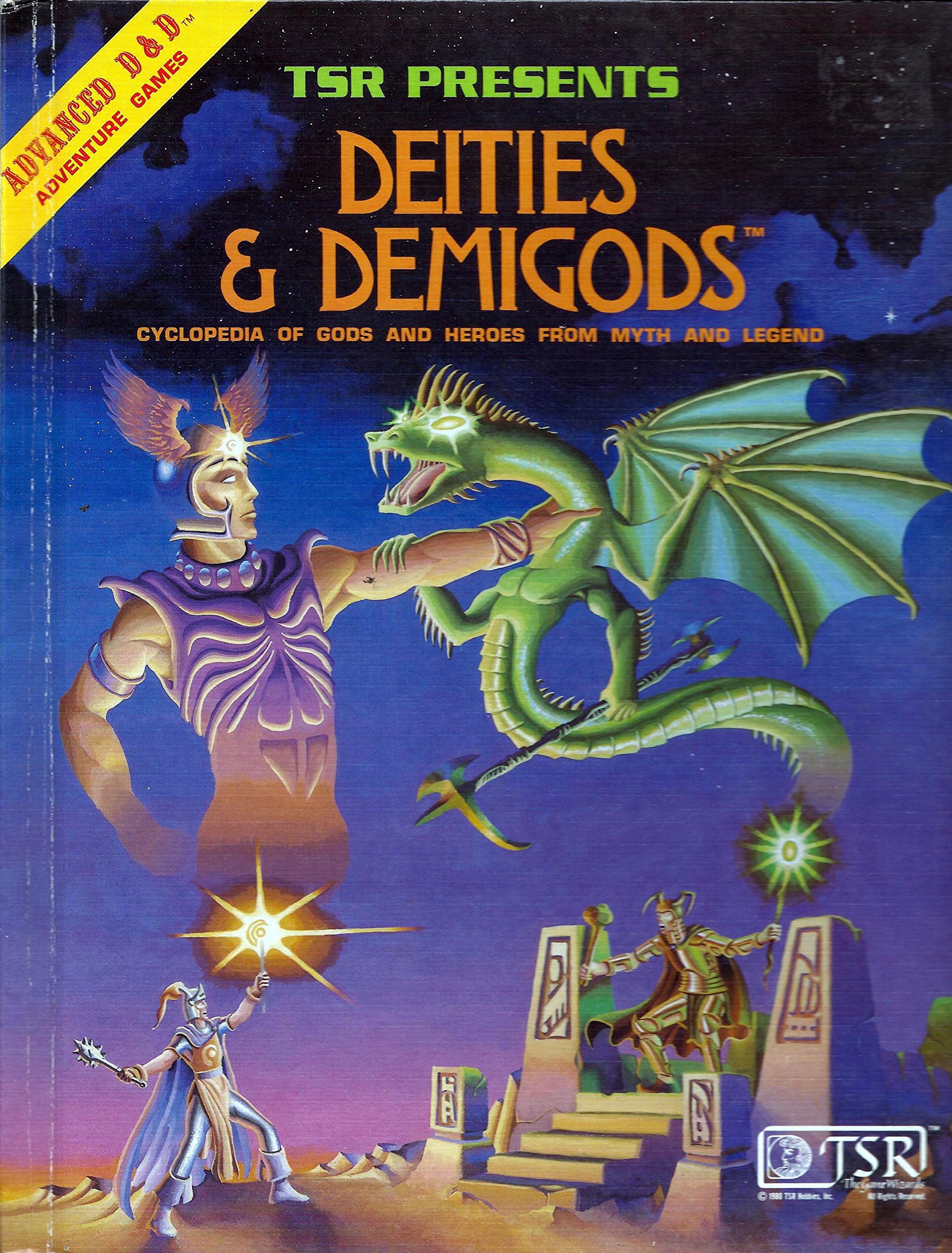
Book Review: Deities and Demigods (1980)
Probably one of the first sourcebooks put out for Advanced Dungeons & Dragons was Deities and Demigods, a book with a collection of beings that would provide something for your Cleric to be, well, a cleric of. However, it doesn’t really hold up very well, particularly compared to later deity books for later editions of AD&D and D&D. Continue reading
